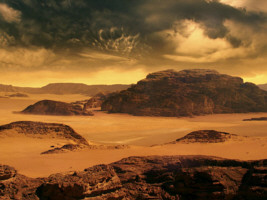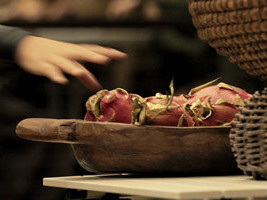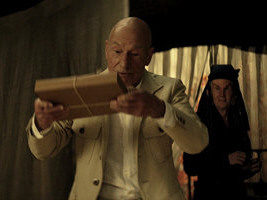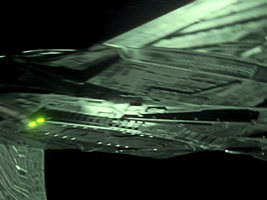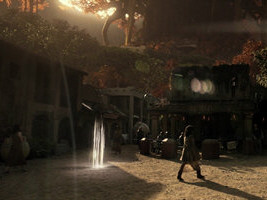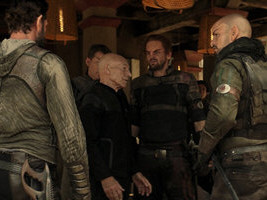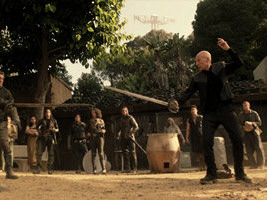Observations in PIC: "Absolute Candor"
by Jörg Hillebrand and Bernd Schneider
Here are some observations about sets, props, make-ups and visual effects in PIC: "Absolute Candor", with special attention to continuity with previous Star Trek series and movies.
Chronological List
Observation 01
All the shuttles in orbit around Vashti are modifications of the Class C shuttles from Star Trek Discovery. As already on Earth in the previous three episodes, there are different color variations of the shuttle, like yellow or red shuttles as seen on the very left of the screen cap from "Remembrance".
Observation 02
Vashti seems to be located in a binary star system. The surface of the planet looks oddly familiar: The same footage (filmed in Jordan) was used for "Absolute Candor" and the surface of the Crepusculan homeworld in Discovery's "The Vulcan Hello". Re-using planet surfaces is an old tradition on Star Trek.
Observation 03
Pixmit cards are used as playing cards for an interesting Romulan board game in this shot. An insect native to Vashti appears in the foreground. The board game might be a simpler version of the game seen in Narek's quarters aboard the Borg cube, as the playing pieces (coming in three colors) and the triangular shapes on the board look similar.
Observation 04
The checkered shirt worn by this Romulan is very evocative of the Romulan military uniforms and Senate robes seen in "Star Trek Nemesis", which featured a similar checkered pattern.
Observation 05
The fruit young Elnor nicks in this scene looks like an Earth dragon fruit or pitaya.
Observation 05a
Picard beams down in the middle of the colony on Vashti. Notice how the beam-down effect is now slightly different from the beam-up effect, which can be seen later in the episode (#14a). When somebody is beamed down, the transporter pattern appears from top to bottom, while it disappears from bottom to top when somebody is beamed up.
The scenes set in the colony were filmed in the Old Mexico outdoor set on the Universal Studios lot, explaining why many of the Romulan buildings have a very Mexican vibe. One particularly prominent Mexican-style building will show up some time later in the episode.
Observation 06
The white hat Picard wears on Vashti was previously seen in his home in "Remembrance". Like in "The End is the Beginning", he is seen wearing the communicator introduced with the third season of Deep Space Nine.
Observation 07
The Romulan on the left wears an interesting piece of jewelry behind his ear (or a communication device). His clothes (or maybe just a blanket?) also evoke the robes worn by the Romulan senators in "Star Trek Nemesis" seen above.
Observation 07a
A futuristic street lamp and what looks like a traditional ornate Japanese lamp can be seen in this shot showing the colony on Vashti. Romulan street lights previously showed up on Romulus in "Unification I+II".
Observation 08
The Romulan social club is shown in the foreground with a massive red-leafed tree, seen earlier in the establishing shot of the colony, in the background. The photo from the Universal Studios Old Mexico set shows the location in real life.
Observation 09
Picard presents Elnor with an old edition of The Three Musketeers by Alexandre Dumas. A musketeer looking like Picard appeared in one of Barclay's holoprograms in TNG: "Hollow Pursuits".
Observation 10
The Romulan nuns are eating the sweet hanifak Picard brought as a gift in the following scene.
Observation 11
Picard has been seen fencing in several previous TNG episodes, including "We'll Always Have Paris" and "I, Borg".
Observation 12
Picard reads from The Three Musketeers as a full moon is shining in the background. A moon orbiting Vashti was already seen in the establishing shot earlier in the episode.
Observation 13
Picard's communicator can clearly be seen still attached to his jacket, so he must be wearing some earpiece when he is responding to Raffi's call in this scene.
Observation 14
The outfits worn by Zani and the other Qowat Milat show some similarities to the outfit worn by Bajoran Kai Opaka in the early seasons of Deep Space Nine.
Observation 14a
As Picard is beamed up, the transporter streaks move from the bottom to the top.
Observation 15
The stern of the La Sirena can be nicely seen in this cap. The last time we saw the ship in "The End is the Beginning". It went to warp in a similar shot.
Observation 16
Rios is still reading the same book he was in the previous episode. The publisher (Abyssus) can be seen much better in this shot.
Observation 17
The warp effect as seen from the bridge or cockpit of a ship looks very different from the way it did on TNG as can be seen in the screen cap from "Rightful Heir".
Observation 18
The backrest cover of the La Sirena Captain's chair now features the logo of the ship, also seen on cargo crates and communicators later in the episode. In the previous episode, the backrest was still plain.
Observation 19
The holographic recreation of the vineyards around Château Picard is really spot-on, as the same footage as in the pilot episode was used. The same workers are standing at the same locations as they did in "Remembrance". Only the watering machines are missing and the clouds were changed. The view out of Picard's bedroom ("Remembrance") must thus be identical to the view out of his study ("Absolute Candor").
Observation 20
There seems to be a long selenite crystal lying on Picard's desk. Crystals on Picard's ready room desk have a long tradition, as the screenshots from "Where Silence Has Lease" and "The Loss" show. Another crystal on his desk is seen a little better in the second cap from later in the episode.
Observation 21
This was a tough one to identify! The old French book on which Dahj's necklace is resting is Cristal fêlé by Jules Ricard. Pages 174 and 175 are visible. The author is rather obscure and not much can be found online about the novel. It is thus possible that the book was only chosen because "Ricard" and "Picard" look and sound very similar.
Observation 22
A black and white photo can be seen on the sideboard, next to the small sculpture. The photo shows Picard with Mark Twain. The photomontage was originally created for The Autobiography of Jean-Luc Picard by David A. Goodman. The composite uses a photo of Picard in the clothes he wore in "Time's Arrow II" and a photo of Mark Twain, originally with John T. Lewis.
Next to that photo is another image originally created for the above mentioned autobiography. It shows Picard as a Starfleet Academy graduate.
Observation 23
The painting behind Picard is a self-portrait by Camille Pissarro, currently housed in the Van Gogh Museum in Amsterdam.
Observation 24
The entrance to the holographic recreation of Picard's study can be seen in this shot. The painting next to the door is Sir Neville Wilkinson on the Steps of the Palladian Bridge at Wilton House by John Singer Sargent.
The upper drawing is named "Veduta del Porto di Ripetta" by Giovanni Battista Piranesi.
There also seems to be a medal in front of the sculpture under the glass case.
Observation 25
Several fossils (including one of a trilobite) are placed on the left side of the mantelpiece in Picard's study. Fossils (usually ammonites) in Picard's ready rooms aboard the USS Enterprise-D and USS Enterprise-E have a long tradition as can be seen in the caps from "The Dauphin", "The Best of Both Worlds I" and "Star Trek: First Contact".
Observation 26
This shot shows the La Sirena at warp. The hull painting of the ship is oddly reminiscent of Eddie Van Halen's Frankenstrat guitar.
Observation 27
We can identify the following works of art:
- The painting behind the lamp is a sketch by the Italian artist Cherubino Alberti called Saints Peter and Paul.
- The sketch of dogs next to it is called Five studies of a French Pointer by Richard Parkes Bonington.
- The colorful painting is Christ on the Mount of Olives from the 15th century.
- The sketch on the right is Costume Studies by Jean-François Millet.
Observation 28
The recreation of Picard's study also includes the same tea set he served Dahj and Dr. Jurati tea with in "Remembrance" and "Maps and Legends" respectively.
The music that plays during the whole scene in Picard's study is Bach's Suite No.1 in G major.
Observation 29
A new type of Romulan bird-shaped starships is seen flying around the Borg cube in this shot. The Romulan transports introduced in "Remembrance" and seen again in "Maps and Legends" are nowhere to be seen.
Observation 30
Ramdha can be seen in a video showing her before she was assimilated from the Borg and then liberated by the Romulans. A photo of Dahj and Soji is also visible on the desk.
Observation 31
Soji puts another pixmit card on the table, underneath the card called "Seb-Cheneb" (The Destroyer), as Ramdha mentions "the Destroyer" in the Romulan talk show.
Observation 32
Vashti and a graphic of its planetary defense system as seen from the bridge of the La Sirena.
Observation 33
Like the Captain's chair, the other bridge chairs of La Sirena now feature a headrest with the logo of the ship. The comparison shot from "The End is the Beginning" shows that the whole headrest was not yet present in that episode and the upholstery was still different as well. It seems that Rios cared for some proper branding, knowing that he has a renowned client.
Observation 34
14 years after his last visit seen earlier in the episode, Picard beams down in front of the Romulan Social Club.
Observation 35
Though not explicitly stated in "Absolute Candor", this seems to be the symbol of the Romulan Rebirth Movement that was mentioned in the exposition of the episode.
Observation 36
When he beams down to Vashti, Picard is wearing a communicator with the logo of La Sirena.
Observation 37
Ramdha's Borg implants are scanned with a Romulan device.
Observation 38
Scanner probes like the one scanning Ramdha here, were previously seen aboard the Borg cube in "Maps and Legends". The new Romulan logo and the wall panels, evocative of a Romulan bird, are also visible in the second screenshot.
Observation 39
Soji and Narek are drinking Romulan ale in this scene. The drink is easily recognizable by its blue color and the characteristic bottle in which it comes. The drink and the bottle first appeared in "Star Trek II: The Wrath of Khan" where it was given to Captain James T. Kirk by Dr. McCoy as a birthday present.
It can barely be seen in the episode (or the film) but the bottle features a label seen much better in publicity shots from "Absolute Candor" and auction photos of the prop from the second Star Trek movie.
In "Inter Arma Enim Silent Leges", a slightly opaque version of Romulan ale was served in bottles clearly inspired by the bottle from the second Star Trek film. The drink is seen both on the USS Bellerophon and on Romulus. Romulan ale also appeared in "Star Trek VI: The Undiscovered Country" and "Star Trek: Nemesis" (only identified as such in the latter film by a reference in the script and by its blue color). In both cases it was served from decanters and not from the characteristic bottles.
Observation 40
When Soji follows Narek through the Borg cube, she tilts her head to the side when reacting to what he has said, in a way which is oddly reminiscent to what Data often did in TNG. In "Hero Worship", Timothy, the only survivor of the SS Vico, copied Data's mannerism in a similar way.
Observation 41
The photo of Picard in a 2380s Starfleet uniform previously appeared in "Children of Mars" and "Remembrance". The text next to the photo reads "Positive of former Admiral Jean Luc (sic!) Picard" and "Incoming subspace hail".
Observation 42
A disk-shaped star chart, featuring several sectors or sub-sectors, is briefly seen on La Sirena's holographic display before remote footage of the antique Romulan Bird-of-Prey is displayed. (Partial) disk-shaped star charts also appeared in several TNG episodes, like "Hero Worship" (Sector 97) or "Cause and Effect" (Typhon Expanse).
Observation 43
Shuttles and other small ships can be seen flying in the distance in this shot of Elnor inspecting his tan qalanq, a type of Romulan sword used by the Qowat Milat.
Observation 44
The Qowat Milan make heavy use of glass bottles, decanters and drinking glasses partially covered with rattan or wicker, as can be seen in this screen cap.
Observation 45
When comparing this establishing shot of the colony (left) with the one from earlier in the episode (right, see also #2) showing the colony 14 years earlier, only a few differences can be noticed. The moon and the suns are located at exactly the same locations in both screenshots. The color of the structures in the foreground is less "new", maybe the metal has corroded. There is a lot less shuttle traffic and curiously, the large red-leaved tree in the distance (the one under which the Qowat Milan make their home) is a little shorter in 2399 than it was in 2385.
Observation 46
The La Sirena enters orbit of Vashti. The planetary defense system is clearly visible.
Observation 47
The Romulan Social Club, as it appeared in the year 2399, can be nicely seen in this shot. A comparison photo shows the Old Mexico Set from a similar angle.
For the appearance in the year 2399, the human writing on the right and left sides of the big sign was removed and the "Romulans Only" sign was added.
The two rotating structures to the left and right of the sign are commercially available "Happybuy Wind Turbines". The same turbines were also seen at Starfleet Headquarters during the fight scene between the Romulan assassins and Dahj in "Remembrance".
Observation 48
The building in the background of several shots bears more than a passing resemblance to the famous Alamo Mission in San Antonio. The church is also visible in the model of the Alamo built by Miles O'Brien and Julian Bashir in the final season of DS9. The building on the Universal backlot looks even more like the Alamo Mission, as can be seen on a photo of the set.
Observation 49
Streets with Romulan signs and writing on walls, like in the Romulan Social Club, also appeared on Romulus in the two-parter "Unification I+II".
Observation 50
The disruptor pistol used by the Romulan Rebirth Movement can be nicely seen in this and in later shots from the episode.
Observation 50a
The sign behind Picard reads "North Station Guest House" and features some writing that does not seem to be Romulan.
Observation 51
The vertically written Romulan language is nicely seen on a wall in this scene. The comparison shot from "United" shows what the Romulan language looked like in previous incarnations of Star Trek.
Observation 52
Close-ups of the hilt of the swords used by the members of the Romulan Rebirth Movement. The sword is inscribed with Romulan writing.
Observation 53
As previously mentioned, earlier episodes in which Picard was seen fencing were "We'll Always Have Paris" and "I, Borg". The buildings in the background can also be seen on a photo from the Universal Studios Old Mexico set.
Observation 54
Another episode in which Picard refuses to fight by throwing down a blade weapon given to him was "Darmok". In that episode, the Captain also wore a uniform jacket for the first time that seems to have been the inspiration for the jacket he wears for the scenes on Vashti. Also notice how the lower part of his La Sirena communicator has suddenly disappeared in this shot.
Observation 55
Another good look at the sign of the Romulan social club with the stylized Romulan writing, the wind turbines and the Romulan disruptor pistol.
Observation 56
Green Romulan blood is seen as Tenqem Adrev is decapitated. Green Romulan blood appeared in several earlier episodes and films, including "The Enemy" and "Star Trek: Generations".
Observation 57
Picard's communicator is fully intact again. Several human (called Terran in this episode) settlers are seen behind Picard.
Observation 58
In a short amount of time, the lower part of the La Sirena insignia on Picard's jacket is present, disappears and is present again.
Observation 59
Green Romulan blood drips from Elnor's tan qalanq.
Observation 60
Notice how there is a "No Romulans" sign in the background, similar to the "Romulans Only" sign seen earlier in the episode, curiously written with the same font. It means there still is a human quarter in the colony. This is further evidenced by the human settlers in the background, which are most prominent in this scene (and in the flashbacks to 2385 when Romulans and humans still got along).
Observation 61
Another beautiful shot of La Sirena in orbit of Vashti. In contrast to the earlier, very similar shot, the engines glow much less noticeably here, maybe because the ship was just waiting in orbit.
Observation 62
The logo of La Sirena, previously seen on the backrest of the chairs in the cockpit section and on Picard's communicator, also appear on cargo crates here.
Observation 63
The circular wall panel with six smaller circles and one larger one is similar to the top of the transporter alcove in the transporter room aboard the USS Enterprise-D.
Observation 64
A small armory with an assortment of rifles, pistols and other gadgets seems to be located to the right side of the transporter platform on the aft section of La Sirena.
Observation 65
This shot gives us a good idea of the size of the large main room aboard La Sirena.
Observation 66
The small cube on Narek's nightstand is similar to a toy played with by one of the Romulan disordered in "The End is the Beginning". It looks remarkably like a fidget cube.
Observation 67
A good look at the holographic control interfaces in use aboard La Sirena.
Observation 68
La Sirena is evading the twin disruptor beams of the Romulan Bird-of-Prey in orbit of Vashti.
Observation 69
In this and a later shot, the bird-of-prey painted on the ventral side of the antique Romulan ship can be seen particularly well. The bird looks different from the one painted on the underside of the ship in TOS.
Observation 70
The planetary defense network of planet Vashti fires at La Sirena.
Observation 71
Compare these shots of the Romulan-Bird-of-Prey from "Absolute Candor" with similar views from the regular and remastered versions of "Balance of Terror". In the second shot from "Absolute Candor", we also get a good idea of what La Sirena looks like from the front.
Note the paneling of the slightly re-imagined Bird-of-Prey, which is more pronounced than it was in TOS-R, whereas the original TOS model (that sadly doesn't seem to exist any more) had no hull panels.
Observation 72
Seven of Nine's ship is one of only a few ships of Star Trek with an asymmetrical hull structure. Other examples include the Borg renegade ship from "Descent I+II", the Breen cruiser from the final season of DS9 and the Tandaran patrol ship from "Detained".
Observation 73
The asymmetrical shape of Seven's small ship can also be seen well in this graphic analyzed by Raffi.
Observation 74
La Sirena and Seven of Nine's ship join forces to cut off one of the Bird-of-Prey's nacelles. We rarely see ships on Star Trek combine forces like this. Comparison screenshots from both versions of "Balance of Terror" and the remastered version of "The Enterprise Incident" reveal how closely the model seen in this episode matches the ship from The Original Series.
Observation 75
Seven of Nine's ship is destroyed when it collides with the forcefield created by the planetary defense network of Vashti. Planets in the Chin'toka system were defended in a similar way during the Dominion war, as can be seen on the cap from DS9: "Tears of the Prophets", showing a network of Cardassian orbital weapon platforms.
Observation 76
Seven of Nine beams aboard La Sirena. The cap from "Endgame" shows what she looked like when we last saw her. As can be seen, her Borg implants have changed slightly.
Credits
Most screen caps from TrekCore and Trek Caps. Thanks to Philoust123 for a correction about the picture Veduta del Porto di Ripetta.







 Planet Vashti and shuttles in PIC: "Absolute Candor"
Planet Vashti and shuttles in PIC: "Absolute Candor"





